ข่าวสารตลาด & มุมมองเชิงลึก
ก้าวนำตลาดด้วยมุมมองเชิงลึกจากผู้เชี่ยวชาญ ข่าวสาร และการวิเคราะห์ทางเทคนิค เพื่อเป็นแนวทางในการตัดสินใจซื้อขายของคุณ.

Most traders understand EA portfolio balance through the lens of traditional risk management — controlling position sizes, diversifying currency pairs, or limiting exposure per trade.
But in automated trading, balance is about deliberately constructing a portfolio where different strategies complement each other, measuring their collective performance, and actively managing the mix based on those measurements.
The goal is to create a “book” of EAs that can help diversify performance over time, even when individual strategies hit rough patches.
A diversified mix of EAs across timeframes and assets can, in some cases, reduce reliance on any single strategy. This approach reduces dependency on any single EA’s performance, smooths your overall equity curve, and builds resilience across changing market conditions.
It’s about running the right mix, identifying gaps in your coverage, and viewing your automated trading operation as an integrated whole rather than a collection of independent systems.
Basic Evaluation Metrics – Your Start Point
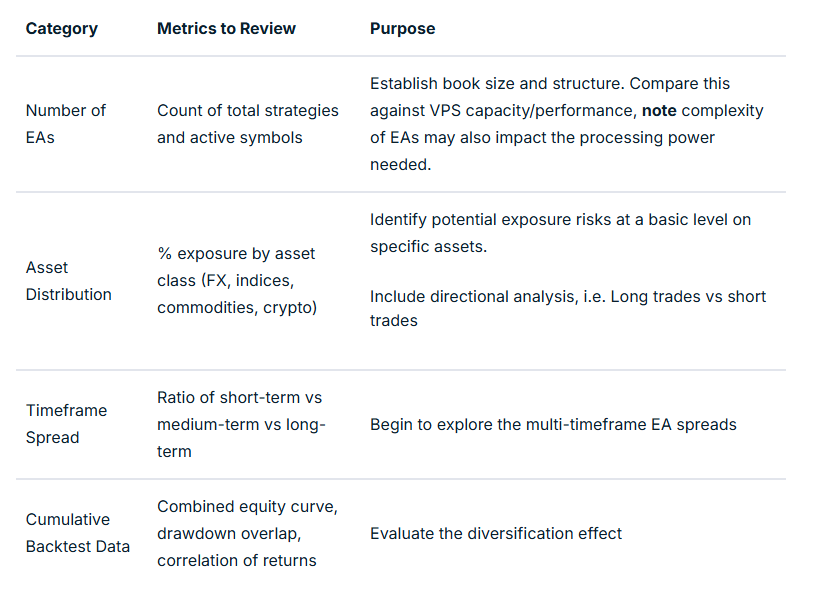
Temporal (timeframe) Balancing
When combined, a timeframe balance (even on the same model and instrument) can help flatten equity swings.
For example, a losing phase in a fast-acting M15 EA can often coincide with a profitable run in an H4 trend model.
Combining this with some market regime and sessional analysis can be beneficial.
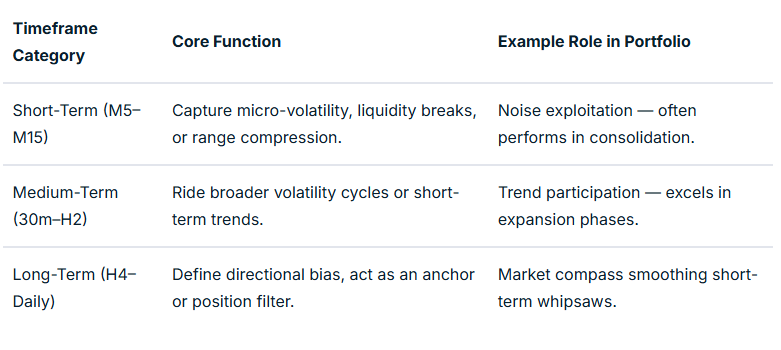
Asset Balance: Managing Systemic Correlation Risk
Running five different EAs on USDJPY might feel diversified if each uses different entry logic, even though they share the same systemic market driver.
But in an EA context, correlation measurement is not necessarily between prices, but between EA returns (equity changes) relating to specific strategies in specific market conditions.
Two EAs on the same symbol might use completely different logic and thus have near-zero correlation.
Conversely, two EAs on a different symbol may feel as though they should offer some balance, but if highly correlated in specific market conditions may not achieve your balancing aim.
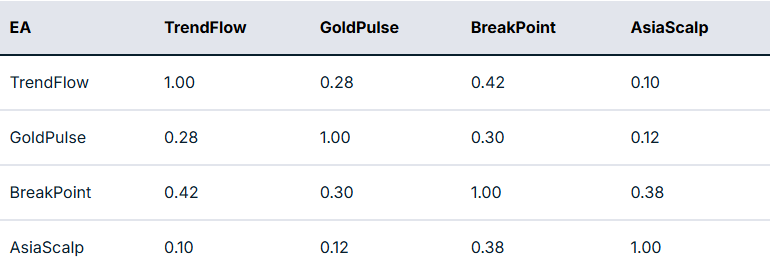
In practical terms, the next step is to take this measurement and map it to potential actionable interventions.
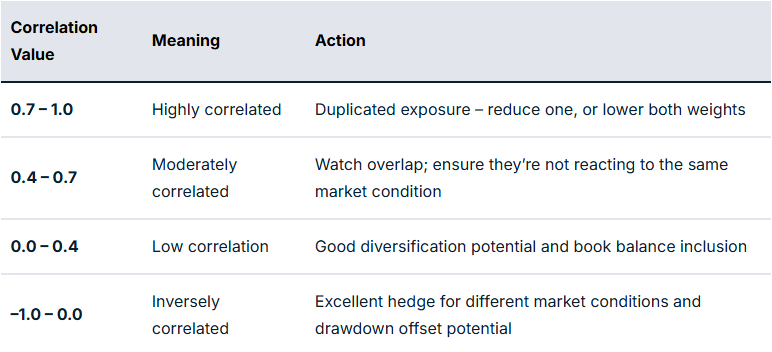
For example, if you have a EURUSD Trend EA and a GBPUSD Breakout EA with a correlation of 0.85, they are behaving like twins in performance related to specific market circumstances. And so you may want to limit exposure to some degree if you are finding that there are many relationships like this.
However, if your gold mean reversion EA correlates 0.25 compared to the rest of your book, this may offer some balance through reducing portfolio drawdown overlap.
Directional and Sentiment Balance
Markets are commonly described as risk-on or risk-off. This bias at any particular time is very likely to impact EA performance, dependent on how well balanced you are to deal with each scenario.
You may have heard the old market cliché of “up the staircase and down the elevator shaft” to describe how prices may move in alternative directions. It does appear that optimisation for each direction, rather than EAs that trade long and short, may offer better outcomes as two separate EAs rather than one catch-all.
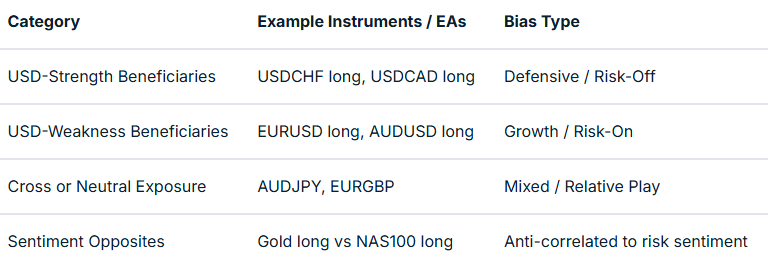
Market Regime and Volatility Balance
Trend and volatility states can have a profound impact on price action, whether as part of a discretionary or EA trading system. Much of this has a direct relationship to time of day, including the nature of individual sessions.
We have a market regime filter that incorporates trend and volatility factors in many EAs to account for this. This can be mapped and tested on a backtest and in a live environment to give evidence of strategy suitability for specific market conditions.
For example, mean reversion strategies may work well in the Asian session but less so in strongly trending markets and the higher volatility of the early part of the US session.
As part of balancing, you are asking questions as to whether you actually have EA strategies suited to different market regimes in place, or are you using these together to optimise book performance?
The table below summarises such an approach of regime vs market mapping:
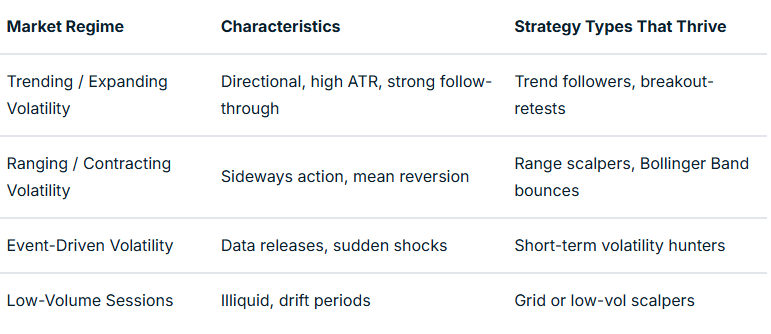
Multi-Level Analysis: From Composition to Interaction
Once your book is structured, the challenge is to turn it into something workable. An additional layer of refinement that turns theory and measurement into something meaningful in action is where any difference will be made.
This “closing the circle” is based on evidence and a true understanding of how your EAs are behaving together. It is the step that takes you to the point where automation can begin to move to the next level.
Mapping relationships with robust and detailed performance evaluation will take time to provide evidence that these are actually making a difference in meeting balancing aims.
To really excel, you should have systems in place that allow ongoing evaluation of the approaches you are using and advise of refinements that may improve things over time.
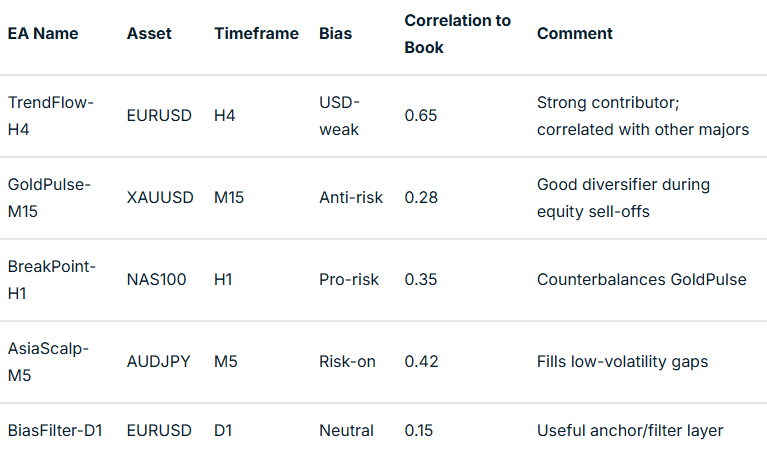
What Next? – Implementing Balance in Practice
Theory must ultimately translate into an executable EA book. A plan of action with landmarks to show progress and maintain motivation is crucial in this approach.
Defining classification tags, setting risk weights, and building monitoring dashboards are all worth consideration.
Advanced EA traders could also consider a supervisory ‘Sentinel’ EA, or ‘mothership’ approach, to enable or disable EAs dynamically based on underlying market metrics and external information integrated into EA coding decision-making.
Final Thoughts
A balanced EA portfolio is not generated by accident; it is well-thought-out, evidence-based and a continuously developing architecture. It is designed to offer improved risk management across your EA portfolio and improved trading outcomes.
Your process begins with mapping your existing strategies by number, asset, and timeframe, then expands into analysing correlations, directional bias, and volatility regimes.
When you reach the stage where one EA’s drawdown is another’s opportunity, you are no longer simply trading models but managing a system of EA systems. To finish, ask yourself the question, “Could this approach contribute to improved outcomes over time?”. If your answer is “yes,” then your mission is clear.
If you are interested in learning more about adding EAs to your trading toolbox, join the new GO EA Programme (coming soon) by contacting [email protected].


Oil has been thrust back into the spotlight as the negative catalyst for markets. The events over the weekend highlight just how fragile the Middle East is and how it will shape global trading in the second half of 2025.Putting Iran in an oil-specific perspective, despite rising geopolitical tensions, the potential for sustained disruptions to energy supply appears limited for now. This is backed by historical data seen in April, June, and October last year, where heightened risk didn't translate into prolonged price surges.There are absolutely geopolitical concerns around Iranian retaliation, coupled with Israeli retaliation, and so on. But the likelihood of strikes on regional energy infrastructure appears low.Iran’s relationships with Gulf nations have improved markedly, reducing the risk of hostile action toward their oil operations. This has been led by Saudi Arabia, which will be strong in ensuring no disruption to global oil supplies. The caveat is if Iran decides to go at it alone and block the Strait of Hormuz, which would severely impact the likes of Bahrain, Qatar, the UAE, Kuwait, and Iraq. This appears unlikely, but a risk we need to be aware of.
Where does diplomacy sit?
Expectations are for tensions to spike in the short term. However, that will likely lead to renewed diplomatic engagement, particularly if the alternatives prove economically or strategically untenable (i.e., long-term war, regime changes, civil unrest). That's the long term; the near-term resolution is the concern. The United States and the greater regions of Europe and Asia will be brought in. We know that the President has a very high preference for low oil prices as a major part of his election campaign. With no signs, demand is likely to collapse. The only way to keep prices down on this escalation is to ramp up supply. The catch is that US producers remain very reluctant to ramp up supply at current prices. OPEC and Saudi Arabia have already moved to increase production to stamp out non-OPEC members on price, and Russia is still a global pariah with its war with Ukraine. So the supply lever is going to be tricky.
So, what about pricing?
Energy price volatility is being closely tied to positioning in the futures market. Historical patterns show a strong correlation between net longs and Brent pricing.If we speculate that short positions were to be fully unwound (from 187k lots to zero), the implied move could be around $14 per barrel. Brent recently hit $65 per barrel before the conflict and spiked to an intraday high of $78.5 per barrel on the news breaking. This reflects the type of technical squeezes we can expect. Sustained gains would then require fresh long positioning.
Summary
The market remains focused on how Iran and Israel might respond further, and whether any escalation might target energy infrastructure directly. Meanwhile, the U.S. continues to signal interest in keeping diplomatic channels open. Unless Iran decides to go against all expectations and independently block the Strait of Hormuz, we can expect heightened volatility in the short term, without any prolonged surge — similar to the patterns we saw during heightened tensions throughout last year.


Last week, the simmering geopolitical situation in the Middle East took a dramatic turn with Israel launching large-scale airstrikes on Iran. Primarily targeting nuclear and missile sites and key Iranian leaders, fears are increasing of a move towards Iran developing local nuclear development capability.. In the days since, Iran has retaliated with missile and drone strikes on Israeli cities, with continuing attacks in both directions further prompting fears of a wider conflict that could disrupt vital energy routes and drag global powers deeper into a standoff.Markets have already responded to the conflict. We’ve seen concerns over the supply of oil, a pull-back in equities that were within 2% of record highs, and a large shift towards “flight to safety” assets. For traders, this situation adds yet another challenge to the recent high-volatility conditions they have been facing. It further necessitates adherence to a robust, flexible approach to take advantage of opportunities whilst managing the risks of any fast-moving, headline-driven situation. Of course, the situation can turn on a dime both in ferocity and market impact, so this “snapshot” article should be taken as such — it cannot be stressed enough that keeping an eye on the latest developments will be critical in the coming days.
What’s Happening: The Escalation So Far
In just a few days, the situation has moved from a first-phase targeted operation to a broader and predictable conflict:14/06: Israeli strikes disabled major parts of Iran’s Natanz nuclear facility. Satellite images and local reports show extensive structural damage and large power grid failures. There are discussions about the effectiveness of the current Israeli missile capabilities to get “deeper” and create permanent damage. The potential for US assistance in supplying such a “bunker buster” has been discussed.15/06: Iran’s response was significant and immediate, with more than 150 ballistic missiles and over 100 drones launched at strategic targets throughout Israel. Tel Aviv, Haifa, and key military sites have been hit. Although Israel’s advanced missile defence systems intercepted the majority of the attack, some ballistic missiles have caused damage and both civilian and military casualties.Today: Further Israeli strikes are now in progress — a promise made from the very start by the Israeli prime minister. Intelligence and media reports suggest significant further escalation will come within the next few days from both sides.
The Global Response
The United States attempted to immediately distance itself from direct involvement in the initial strikes, although they are seen by many in the Middle East as being indirectly involved through the continued provision of military assets to Israel. The US has reinforced military assets in the Gulf as a potential deterrent. It has also warned Iran against targeting American forces or bases in the region.European leaders, including France’s President Macron and Germany’s Chancellor Scholz, have called for an immediate ceasefire and offered to assist in talks that may produce some resolution. Other oil-producing Gulf States, like Saudi Arabia and the UAE, have publicly urged that both sides exercise restraint. Increased security around their own key oil terminals has been put in place. China and Russia have both issued statements condemning the military escalation, but have largely been passive outside of these comments. Global energy agencies and OPEC+ have not announced any emergency production increases yet on top of what has already been planned. Some contingency planning will be underway in case Hormuz traffic faces disruption.
How Markets Are Positioning Right Now
Oil Supply Risk Creates Significant Moves
Both WTI and Brent crude were seeing a strong last month, but price moves have (not surprisingly) accelerated over the last few days, with both now sitting above $75. The risk is physical supply cuts as well as logistical bottlenecks if ships need naval escorts or higher insurance to pass through Hormuz.
Equities Showing Caution
Global indices are down 1–2% from last week’s levels, after eyeing record highs earlier in the week. There appears to be some rotation out of cyclical and travel stocks, with airline stocks dropping sharply due to the potential for rising jet fuel costs and the need to re-route flights away from the affected region. On the other hand, stocks in the defence and energy sectors have benefited, e.g., Lockheed Martin.
Flight to Safety?
Gold has been the major beneficiary — Gold Futures have pushed over 3400 with a record high less than 0.5% away. Both institutional hedging and retail safe-haven flows are evident, while base metals have dropped with a risk-off rotation.The US Dollar index futures are surprisingly weak, continuing a decline, but risk currencies like the Aussie dollar are showing some weakness against most crosses.US Treasury yields have also dropped modestly through the week.
Five Things to Watch Now
It is relatively early days in this conflict, and how it evolves will determine whether this is a short-lived geopolitical spike or a sustained macro theme that will impact markets on an ongoing basis. There are a few key watchpoints:
- Strait of Hormuz traffic and shipping costs
If insurers price routes significantly higher, or military convoys are needed, oil can spike further, even if there are no direct physical attacks on tankers.
- Prolonged follow-up and “wider” strikes
Continued Israeli raids and Iranian retaliation, and involvement of regional oil infrastructure (like Saudi or UAE pipelines) would be major escalation triggers on oil prices.
- OPEC and emergency output decisions
So far, the major energy organisations have been quiet. Prolonged conflict will force decisions and announcements to be made, with perhaps further increases in oil production.
- Central Bank Rate Impact
Watch Fed, ECB, or RBA statements for clues on whether there may be perceived additional oil-driven inflation risks that may push back any rate cut timeline expectations. The Fed is not expected to offer a likely cut until September, but the RBA is expected to cut at their next meeting
- Volatility
The volatility that markets have experienced this year is likely to continue if any conflict is prolonged and/or escalates. As always, markets struggle with uncertainty and with threats to global growth already on market minds, an increased sensitivity to any news events may be likely.
How to Adapt: System, Entry & Exit Tweaks
In tense geopolitical markets, some trading strategies may need adjusting. It may not be a market that is forgiving for traders caught up in every small headline or succumb to any greed-based actions.Be more selective: Use stronger confirmation before entering breakouts or reversals. e.g., wait for a second bar close above a key level rather than a single spiking candle.Look for confluence: Combine price action with volume increases and confirmation candles to reduce the potential whipsaw risk.Increase use of partial closes: Taking profit on half a position when a logical target is hit could be a tactic worth consideration, trail the rest with a tighter stop.ATR-based trailing stops: Another consideration is to adapt to wider intraday ranges that will be typical in many asset classes.Reduce position size per trade: Lowering tolerable risk levels, especially on leveraged trading instruments, perhaps to 1% risk or below on single trades.Consider more instruments: Use more instruments with a lower correlation to “either way” significant oil price shocks. e.g., lessen exposure to Canadian dollar crosses.Be cautious in headline-driven markets: Any belief as to what is likely to happen should be balanced with the reality that the situation can and is likely to change unpredictably. Don’t be afraid to change your mind, cut losses early, and take profits perhaps a little more aggressively than your norm. Learn trading lessons from this situation: This situation is likely to repeat many times in the future — use it as an opportunity to learn.Keep an alert watchlist: Arm yourself with the resources likely to give you timely and accurate information. Make sure you track credible news wires — not just opinion articles. Shipping data, OPEC, and EIA statements are worth checking in with regularly. Attend our Live Markets updates on Monday and Thursday, and Inner Circle on Wednesday, to get the latest and ask questions that will help your decision-making.
Summary
The Israel–Iran conflict is (and will continue) to be a sharp reminder that geopolitical flare-ups can collide with an already sensitive macro backdrop. Oil, inflation, movements in gold, and central bank policy are all in play at the moment.For traders and investors, the key takeaway is simple — being active rather than passive in arming yourself with the right information is critical on an ongoing basis. Maintain flexibility in your trading approach based on how markets are actually responding rather than how you think they should be, and adjust your risk and opportunity tactics as appropriate.


Fear of Missing Out (FOMO) is a powerful psychological force that can completely derail your trading potential. It can alter meticulously planned trading decisions, right at the time you’re meant to execute.Having spent many years as a trading coach, FOMO is something I have seen far too often. It masquerades as an urgency to be “in the market” or a stated belief by traders claiming to “feel the market.” Unless you take a step back and honestly evaluate your market behaviour, FOMO can drive you into poorly-timed entries, premature exits, and revenge trades that send your account balance into an ever-decreasing spiral.
What Is FOMO in Trading?
FOMO is the emotional pressure that arises from the belief that you are about to miss out on a profitable opportunity. It is the belief that valid opportunities are few and far between, and if you miss out, it matters.This leads traders to ignore their rigorously tested strategies in favour of emotional reactions. The result is that their trades lack any sort of edge, are poorly timed, and carry too much risk.Many traders report feelings of regret, anxiety, and even shame after making FOMO trades. Over time, this can erode self-confidence and lead to even more impulsive behaviour, creating a negative feedback loop and compounding losses.
Why Does FOMO Happen?
Humans are hard-wired to follow the crowd. When you see traders posting big wins or hear about others catching great trades, your brain sees their success and equates this with missed opportunity.This social comparison triggers an immediate emotional response that can override rational decision-making. People never post their losses or the full context behind their winning trades, so you are only seeing a carefully curated highlight reel that creates a distorted view of success.Recency bias is another major factor in FOMO trading. The tendency to place too much importance on recent events, for instance, if a setup worked extremely well yesterday, you may irrationally believe it will work again today, even if conditions have changed.Recency bias and a scarcity mindset also fuel FOMO trading by making us overvalue recent wins and fear missed opportunities. When yesterday's setup delivered profits, we chase similar patterns today, regardless of changed market conditions. And the belief that profitable setups are rare leads to "itchy trigger finger syndrome" — forced entries driven by the fear that this moment might be our only chance.
How FOMO Shows Up in Trading
Chasing Breakouts
Seeing a strong price move and entering deep into a move (often near the top) is common FOMO behaviour. The trader convinces themselves that it’s better to get in late than miss out entirely, rather than simply accepting to leave it and wait for the next set-up opportunity. This mindset often leads to buying into exhaustion, right before the market reverses.
Overleveraging
The feeling of needing to "make up" for missed trades can cause traders to increase position size on the subsequent trades. While this may lead to larger gains on rare occasions, the fact that the mind is in this “revenge” state can lead to increased use of leverage and worse decision-making, significantly increasing the risk of major losses.
Ignoring Plans
When emotion takes over, traders often abandon their entry criteria, position sizing rules, trade confirmation filters and exit management. The result is a strategy that lacks consistency or any statistical edge from careful creation and evaluation over time of that plan.
Impulse News Trading
Another form of FOMO is jumping into trades during high-impact news events without a planned strategy. The fear of missing out on this visibly happening, large and fast move overrides the caution needed to trade volatile conditions.
Ignoring Take-Profit Targets
Even with predefined profit levels, traders may stay in trades longer, thinking the move potentially “has more legs”. This results in giving back unrealised gains, as rather than pushing further in your desired direction, it reverses and moves back from where it came.
Cancelling Trailing Stops
Traders second-guess trailing stops and move them further away, afraid of being stopped out too soon due to perceived market noise. This leads to worse exits than you may have had should you have left your trail stop as it was.
Holding Through Clear Reversal Signs
Emotional attachment to profit potential causes traders to ignore signals that a trend is reversing, hoping the price will resume its direction. Traders may convince themselves this is merely a retracement, ignoring other signs that a reversal is in progress, e.g. increased volume.
Skipping Partial Closes
FOMO can cause traders to avoid scaling out again despite the pre-trade plan of taking some of the table at specified points. This greed-based decision often results in missing the chance to lock in solid profits. We recently posted an article on mastering partial close that dives deeper into the topic.
How to Manage FOMO
The starting point of managing any psychological challenge in your trading, including FOMO, is to take ownership of it. This means acknowledging that FOMO is your responsibility. Accepting that FOMO impulses originate from within and are entirely under your control is the first step to moving from a reactive approach to a strategic one.Once you’ve come to terms with this, there are several structural and psychological tools and tactics you can employ to avoid future FOMO decisions:
- Realign with your Trading Plans: Every trade should have a specific setup, entry condition, risk limit, and exit plan. Relying on predefined rules helps remove emotional interference. Do a comparison of results when your plan was followed versus when it was not. The chance is that the difference will be obvious and add to the belief that your plan is what you MUST execute under all circumstances
- Controlled Position Sizing: Set out-of-trade limits and always adhere to them when tempted to take any trade. Know that you can ultimately scale, but only on a history of positive outcomes and in a measured way.
- Strategies to trade multiple market conditions: Missing out on a trade will seem less acute if you have a strategy to trade a breakout. Knowing you can bank profit now and simply re-enter a new trade when a break is confirmed is logically preferable to a cross your fingers approach.
- Scaling Out Plans: Having a structured scale-out process helps lock in gains and reduces the temptation to hold everything. Use previous trades and do a “what-if” analysis on a partial close to help build the conviction.
- Increase Journaling: Document details about your trades, including why you took them and how you felt before, during, and after. Pay attention to trades driven by urgency or impulse.
- 10-Second Rule: When you feel the urge to take or alter a trade, pause for ten seconds. Ask yourself: “Is this aligned with my plan or driven by FOMO?”
- Pre-Market Routines: Build routines to get into a focused, rational state before trading begins. Again, we recently published an article on pre-market preparation that may be worth a look.
SummaryFOMO may be a regular part of the human condition, but in trading, it can become one of the most dangerous emotional pitfalls. Without vigilance, it can creep into your trading without you realising. You do not need to catch every trade to be successful, another opportunity will be along soon. You should trade with consistency, discipline, and clarity. Mastering FOMO is not about removing emotion, but having the confidence to follow your strategy, not your fear.


Introduction: The Moment Before the MoveThere is one key habit that appears to separate consistent high-performance traders from the rest, i.e. they fully prepare before engaging in the “battle of the market”.Before a position is amended or a new order is placed, professional traders engage in a ritual or daily agenda (as many of you have heard me discuss on webinar sessions). This is a structured, repeatable pre-market process that puts YOU in the best place to maintain consistency with your trading plan in the context of current market conditions. Arguably, this should be part of your overall trading system or trading business plan.The Daily Market Prep Checklist, which you can download by clicking the button below, has been designed with exactly this in mind, to help traders like you start every trading day fully in tune with both the market environment and your internal trading state.Whether or not you want to take advantage of the free download, this article aims to not only explain each part of the checklist but also explain what to do and why it could be important in your decision-making process.Whether an experienced trader or less so, additional tips have been added so you can move towards fine-tuning your edge or looking to move to the next level.Click Here to Download your Free ChecklistReading the Market's MoodYour first task in your trading day is to understand the current market context.Looking at what happened overnight that may continue to shape the day ahead is vital, not only simply skimming headlines passively, but to actively engage with the flow of global financial information and current drivers. You are trying to build a picture of not only what has happened but what may happen next.This helps in assessing the day’s potential market bias, such as whether it is a bullish, bearish, or range-bound environment, there is generally a risk-on or risk-off narrative and what the flow is in and out of the major asset classes. Additionally, of course, an evaluation of volatility may help inform not only general risk but also how you may approach some of the positioning you may consider, e.g. where to place stops and take profits, as well as position sizing.What matters is that you are asking the right questions to help you form a strategy for the market NOW before you act. It is not about getting things right all the time; this is an unrealistic goal, but surely a considered opinion and approach of where the risks and opportunities may be is far better than going in “blind”.Pro Tip: Market bias is often seen with a review of major global futures; these are the gauges of sentiment. Their pre-market and movement can add weight to your overall market view.Intermediate Trader Tip: Observe whether volatility expectations (e.g., VIX or price action on longer timeframes) are aligning with any technical setups you may be seeing.Risk Framework and PositioningBefore you even open your trading platform, your approach to risk should already be mapped out. How many trades are you willing to have open today, and how much of your account are you prepared to risk per position are ESSENTIAL questions to answer at the start of a trading session.This step is not about limitation. It’s about removing decision fatigue and emotional interference once the market opens, particularly in the event of rapid and significant market moves across multiple positions at the same time. For example, knowing that you’ll only open a maximum of two trades today forces you to be selective and choose those with the strongest set-ups. In addition, “market-oriented” position sizing is a logical way to manage the emotional difficulties of increased account risk due to challenging markets.The Economic Calendar Moves PriceTraders often focus on the technical picture seen on a chart and miss the ticking countdown to scheduled economic events that may move prices in seconds. Whether a central bank decision, CPI data, if there is a significant move away from numbers that were expected, the market doesn’t just respond tamely, but may undergo a major recalibration.Of course, this is not only important in terms of opening new positions but managing the open trades you already have, and you are faced with three choices pre-data release:
- To ride it out
- To tighten trail stops/reduce positions
- Exit positions
Taking a few minutes each morning to scan for high and medium-impact events and making the decision on what action you will take and when will serve you well when attempting to manage risk more effectively in these situations.Intermediate Trader Tip: Start logging how your watchlist instruments react to specific events over time. Journal your chosen approach versus the alternatives to inform you in the future.The Key Levels That Matter: The current price is always interacting with the overall structure of price over time. This reality and a key part of your preparation is about identifying those price points where action is most likely to occur and sentiment changes become apparent. These might be recent highs and lows, clear support or resistance zones and of course, round numbers.Again being prepared through identifying these, particularly those which are approaching such important key price levels can be difference of you getting in or out of a trade at the optimum time as sentiment changes (or doesn’t change suggesting a trend move may be completed), rather than missing an opportunity to get in at the start of a move (rather than later) or taking profit rather than giving it back to the market.Pro Tip: Print your charts with levels marked or take a screenshot each morning. Reviewing these in hindsight builds your pattern recognition and potentially assists in the creation of EAs or informing strategy changes.Beyond the Charts – Knowing Market DriversNot every market move is tied to a pre-defined data release. Often, as we have seen many times of late, unscheduled events can be massively impactful on sentiment. Geopolitical tensions that may escalate, trade talks that may influence industries in the back of a “truth social” post, or policy meetings that may produce outcomes that could shift sentiment, e.g. new policy bills, OPEC meetings.If you can identify two to four potential market drivers beyond the usual data points this may be good information to have when creating your market “picture”, and although you may not have to act on these immediately, knowing that they exist puts you in a better position to respond appropriately rather than react emotionally has got to be a good thing,Pro Tip: Ask yourself: If this potential story escalates, which instruments are likely to move, and what does that mean to what I am going to do/not do today?Personal Readiness to tradeThis is the most overlooked and underrated part of pre-market preparation. As traders, we often feel that we “have to trade” rather than assessing the risk that we are bringing to the table if we are not in the optimum trading state (again, a topic covered in previous webinars).Logically, we need to be able to permit ourselves not to trade or to trade less, if we are not in the best place to make decisions at any time or day.Evaluate where you are at the start of the day with your emotional state, potential out-of-market distractions, and physical wellness. Markets and the potential opportunities that they can give will still be there tomorrow. You must be honest with yourself. If today isn’t the right day, you can reduce size, trade less, or don’t trade at all.Pro and Intermediate Trader Tip: Track your psychological state in a journal alongside trade results. Patterns will emerge. You’ll start to see which states lead to your best performance — and which sabotage it.Click Here to Download your Free ChecklistSummary: The Professional Begins Before the BellThis checklist is not just about technical steps; it’s about creating alignment between you and your interaction with the market. Having considered information that will help form your approach for the day, enables consistency in execution, and this will always be served well by consistency in preparation. Whatever and however you are trading, your process logically should be the same in that you need to do the things not just to prepare to trade but to prepare to perform at the next level you can.The real work starts before the market opens.If you have found the article and particularly the download useful, then we would be delighted with any feedback you can give. Please feel free to connect at any time at [email protected] with any thoughts you have about this or other things that may be useful to you on your trading journey.


IntroductionAs any experienced trader has seen in the reality of the market, knowing when and how to exit trades is arguably as important, if not more important, than knowing when to enter. We have invested a lot of time on Inner circle webinars discussing exit approaches not only in terms of management of potential capital risk i.e. the potential to lose on a trade, but equally as impactful on overall outcomes the approaches you can implement in reducing the amount of “giveback” when in a trade that goes in your desired direction i.e. profit risk.One such approach is to use an incremental method, rather than closing an entire position at once, to lock in profit through the use of a partial close. This, in simple terms, allows a trader to close a portion of their trade, so banking some profit, while keeping the rest open.As with any approach in your trading decision making, and in the quest for consistency in action so you can see what works and doesn’t in your trading system, this should be planned and of course executed with consistency, as through this, discipline you will be able to find the approaches that are a best fit for you and your trading style and objectives.Unfortunately, although many may have dabbled with the concept of partial close, often this is not backed up with that required consistency, rather occurring as a ‘heat of the moment’ ad-hoc decision that may not serve you well for a lifetime of trading.This article aims to help you develop this part of your trading plan exit strategy, defining what partial closes are, how to make them happen with consistency to enable informed system refinement, and the options you can explore for managing the remaining position.What Is a Partial Close?A partial close is a profit risk management approach where a trader exits only a portion of their position prior to a final ultimate profit target being hit. For example, if a trader enters a trade with 1.0 lots, should the trade moves in the desired direction, they might choose to close 0.5 lots once the trade reaches a predefined profit level, allowing the other 0.5 lots to continue running.This technique is commonly used across all trading styles and timeframes and can also be actioned manually or coded within an automated trading system, e.g. with an EA.Advantages of Using Partial Closes
- Lock in Profits: By securing some profit early, traders can realise some of the gains in a position, both the psychological pressure of holding the full position, reducing overall market exposure, as well as locking in some “banked” profit into their trading account.
- Reduce Risk: In practical terms, lowering exposure in a position (and so also the account market exposure) means that if the market reverses, the trader has less monetary risk. In addition to the percentage movement towards a take profit, partial closes can also be used to reduce risk in situations where market risk may be increased, such as prior to economic data release, while still preserving some upside potential if the data comes in favourably compared to what was expected.
- Increase Flexibility: Partial closes can be combined with other exit strategies, including trailing stops or time-based exits, allowing a strategic approach to profit risk management.
- Better Emotional Control: Traders may find it easier to stay disciplined with the remainder of the positions if they know part of their profits are already ”safe”.
Limitations and Challenges
- Capped Upside Potential: Exiting a portion early can reduce overall returns if the trade continues strongly in your favour.
- Complexity: Managing multiple exit points adds layers of decision-making, especially in discretionary trading. This reinforces the advantage of having written “when and how” guidelines for taking action as a formal part of your trading system.
- Trader Knowledge Limitations: Of course, there will be specific ways in which to action partial close on your trading platform. This does require some knowledge on the part of the trader to make sure these are actioned as planned. Methods to do this will differ from one platform type to another, so no assumptions can be made that just because you have done this on a different type of platform that it will be obvious on another. Of course, this can be learned easily through practice on a demo account before implementation on a live account.
Key Components of a Partial Close StrategyThere are three components to any partial close strategy, namely, when to act, how much to close, and your approach to managing the remaining portion of the trade that is still in the market. Let’s consider each of these.
- Timing: When to Perform your Partial Close
There are four common methods used:
- Target-Based: Close part of the trade at a specific reward-to-risk milestone, such as 1R (where R is the initial risk). In this case, it would not be uncommon to have multiple partial closures. e.g. at 1R, 2R etc.
- Technical Level: Exit a portion at known support/resistance or Pivot level to lock in profit at a potential pause or reversal point.
- Progress towards take profit: As referenced earlier, as one of the most common approaches, a preset take profit provides an opportunity to implement a partial close at a percentage move towards your take profit. E.g. you action this at 50% towards your take profit.
- Time-Based: Although less common, set time rules may be the action point. Often, closing part of the position after a certain number of candles or hours may be considered, or as previously referenced, a risk management approach when significant data release is imminent, e.g., CPI, jobs data
- Sizing Adjustment: How Much to Close
There are three potential approaches to this.
- Fixed Size: A predetermined percentage (e.g., 50%) of the position when the specified price target is hit. This is probably the most common and easiest to implement
- Scaled Reduction: Slightly more involved is the approach to gradually close smaller chunks of your position, such as 25%, then another 25% at later levels. The practicalities of this are more difficult to implement, not only in working out what the multiple closes may be in terms of overall position, but also could be difficult to implement with some strategies where a relatively small move is the overall target. In other words, the larger the distance between entry and final expected reversal or pause point, the easier this will be to act on.
- Dynamic Approach: For advanced traders, the option of basing the size of the partial close on trade conditions like volatility or market structure could be considered. In practice, this may take a considerable amount of time and a critical mass of results data to action consistently and may require multiple refinements to achieve such and demonstrate better outcomes than other approaches. For this reason, this is not common.
- Managing the Remainder of the Trade
Once a partial close has been executed, the remaining position still requires management.Options for management include:
- Leave the Stop Loss Unchanged: Allow the remaining portion to play out as per the original plan, maintaining your original full stop-loss distance. The advantage of this is that you still give the market a chance to move rather than the remainder being taken out by “noise”. Those who advocate this method would suggest that it can potentially create a no-lose situation where your partial close has covered your stop, BUT this values your net worth in a position at the entry price, NOT the value after a move in your favour.
- Structure-Based Trail: Move the stop behind recent swing highs/lows, so on each retracement on a move in your direction, you continue to lock in some more profit with the remainder of the trade.
- Move to Breakeven or Beyond: To eliminate the risk of the remaining portion and to improve the potential outcome that the best your partial close does in that described in the first scenario would be to move the stop to the entry price or above (e.g., breakeven +1 ATR) once part of the trade is closed.
Combining With Other Exit MethodsPartial closures do not exist in isolation. They can work alongside other experts such as”
- Fixed Take Profits: Set targets for final exit.
- Time-Based Exits: Exit the remainder if the trade stagnates.
- Trail Stop methods: Exit on reversal candlestick patterns or other dynamic trailing stops e,g, Price vs Moving average
The key is to ensure all components, including those associated with your partial close, are part of a consistently executed and tested strategy.Final Thoughts and SummaryPartial closes offer traders a way to blend some security with the opportunity of locking in gains while keeping the door open for a continued move in your desired direction.They can be particularly effective in volatile environments where prices can swing rapidly between technical zones and in the management of pre-data release situations.Without wanting to labour the point too much as with any trading method you use during the life of a single or multiple trades, the key is having a plan articulated that facilitates consistency, discipline in execution, and evidence-based decision-making following thorough testing of not only this approach but in comparing it against other “what-if” scenarios.We trust that as a minimum, this has given you food for thought it not only whether partial closes could be a fit for your trading but also some guidance about how to action this if you choose to follow through on an evaluation of this exit approach.


In the words of Bjork’ 90s indie hit “Oh So Quiet” –It's, oh, so quiet Shhhh, Shhhh, It's, oh, so still Shhhh, Shhhh, You're all alone Shhh, Shhh And so peaceful until…Until… that is the question, and considering it is ‘peaceful’, it's probably best to review the minutes from the Fed as it is signalling that the quiet time is not far from ending soon.FOMC: The Pressure BuildsThe May 6th to 7th Federal Open Market Committee (FOMC) minutes reaffirmed the Fed’s cautious stance, with Chair Powell keeping to the “wait and see” script. But under the surface, the outlook has become more complicated as event risk is getting louder.Clearly, Trump’s Tariffs have created new complications for the Fed’s dual mandate.As the minutes note:“With uncertainty higher due to ‘larger and broader’ than expected tariffs, the Committee may ultimately face a more difficult trade-off between its price stability and full employment mandates.”And this was well before the Trade Court’s decision that the Liberation Day tariffs are illegal under the Economic Emergency Act of 1977, and then it was subsequently overturned 24 hours later by the appeals court.The Fed has flagged increased downside risk to real activity and now sees the probability of recession as nearly equal to its baseline forecast. At the same time, inflation risks for 2025 have been revised upward, though longer-term projections remain skewed to the upside, particularly as inflation expectations creep higher.Seen in these quotes from the minutes:“The staff continued to view the risks around the inflation forecast as skewed to the upside, with recent increases in some measures of inflation expectations raising the possibility that inflation would prove to be more persistent than the baseline projection assumed.”“Many participants reported that firms planned to partially or fully pass on tariff-related cost increases.”To paraphrase Milton Friedman, “Tariffs are not a tax on the sovereign, they are a tax on the consumer.” And this is what is being missed by government officials and the President himself.A counterargument to higher cost is that Fed officials suggested there is a chance of weakening demand, lower immigration driven housing inflation, and competitive pricing tactics. Which would feed back into the risk of recession as mentioned above, and signal that the US is entering a new stagflation era.Seen here:“Several argued that there might be less inflationary pressure for reasons such as reductions of tariff increases from ongoing trade negotiations, less tolerance for price increases by households, a weakening of the economy, reduced housing inflation pressures from lower immigration, or a desire by some firms to increase market share rather than raise prices.”On employment, the labour market remains tight but is potentially vulnerable to hiring pauses as policy and trade risks weigh.“The labour market was seen as ‘broadly in balance’ and the unemployment rate as ‘low.’”“Participants were concerned that tariff uncertainty could lead to a pause in hiring and the labour market to soften in the coming months.”Financial market signals were mixed. Several participants noted an unusual pattern: long-term Treasury yields rose even as the dollar weakened and equities sold off, raising concerns about shifting correlations and safe-haven perceptions.“Some participants commented on a change from the typical pattern... with longer-term Treasury yields rising and the dollar depreciating despite the decline in the prices of equities and other risky assets... [noting] that a durable shift... could have long-lasting implications for the economy.”Monetary framework discussions continue as well. The Fed appears to be reconsidering its post-COVID commitment to flexible average inflation targeting (FAIT). The minutes state:“Participants indicated that they thought it would be appropriate to reconsider the average inflation-targeting language in the Statement on Longer-Run Goals and Monetary Policy Strategy.”An interesting development is putting more rigidity into the mandate currently, suggesting the Fed is looking to ‘safeguard’ policy changes from external political forces.Where does this leave the US and the Fed in the short term? Don’t expect any near-term policy change, but the longer the Fed delays, the steeper the eventual rate cuts may need to be as the risks of a tariff-induced recession lead to the monetary brake being released.The consensus is that by January 2026, a possible 125 basis point will come out of the Federal funds rate, some even are forecasting 175 due to the need to stimulate the economy rather than restrict it. The consensus figure would see the Federal Funds rate landing on the terminal rate of 3.00% to 3.25%, the unknown is when, the size and velocity of reaching this point will be.It is oh so quiet, but it won’t be for long if the Fed is anything to go by.

